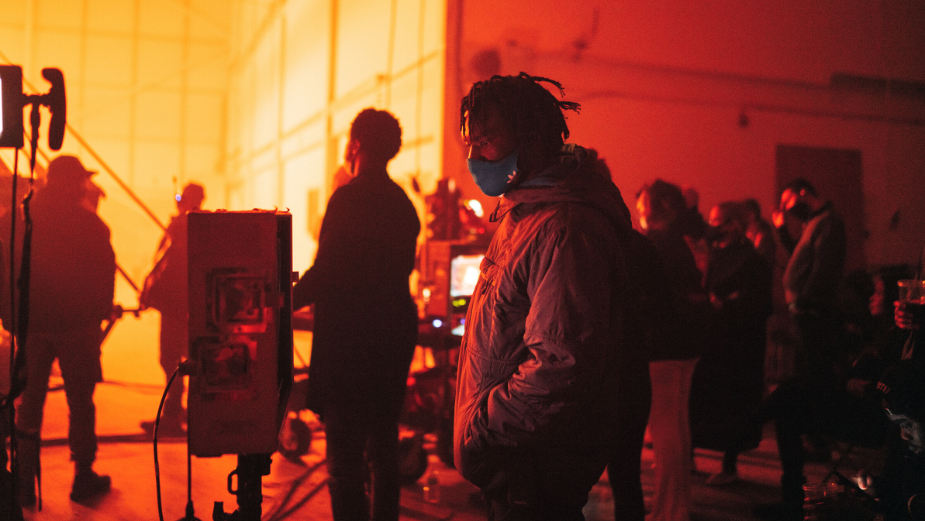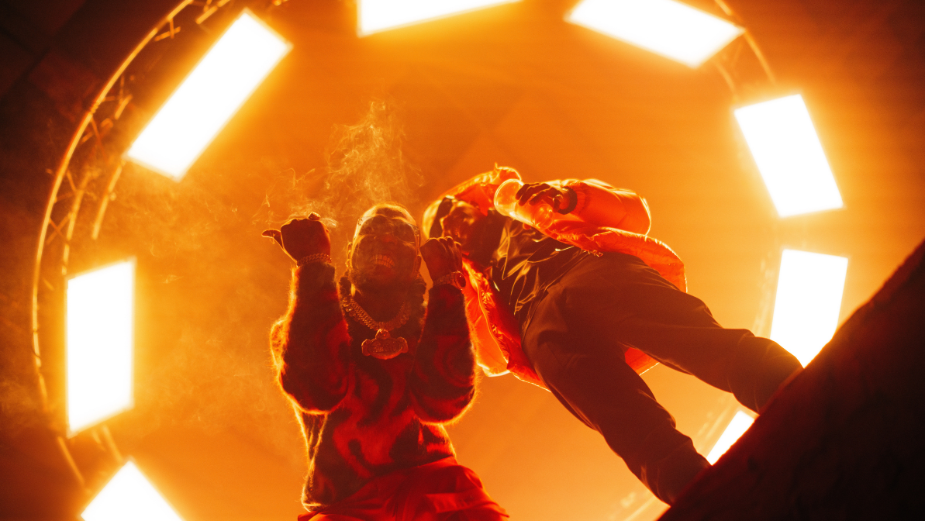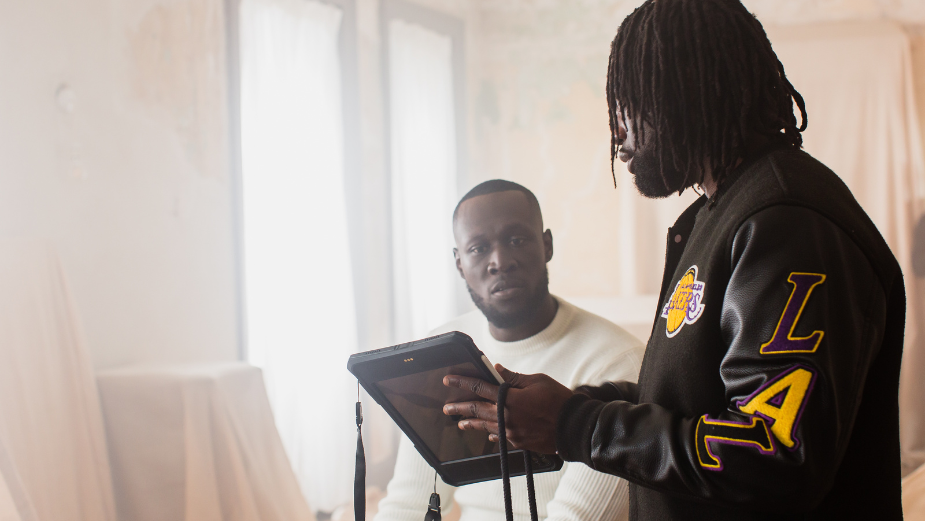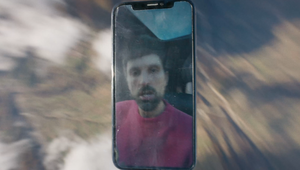
Above and Beyond the Brief: There’s More to Meji Alabi Than Music Videos

Studio RM, the creative studio specialising in colour grading and post production across film, print, and digital, is partnering with Little Black Book to sponsor The Directors channel. It’s a space for celebrating directors who create aesthetically beautiful and nuanced imagery, the creative potential of technology, and diving into the trends in contemporary culture which these visionary minds so often spark.
In this series, we’ll be highlighting directors with a distinctive creative voice, who are championing new and exciting visual styles through fashion, music, and culture. Today, we speak to Meji Alabi, the award-winning filmmaker known for crafting emotive narratives with depth and style which celebrate Black culture, love, family and music.
Having co-founded his own media and production company, JM Films, Meji has directed music videos for a string of Burna Boy and Wizkid’s biggest hits, and most recently collaborated with Stormzy on the video for his new single, Hide & Seek. Rising to the top of the list of most highly sought-after music video directors and photographers in the UK, Meji has only scratched the surface of his creative potential.
In conversation with the director, LBB’s April Summers speaks to Meji about his inherent curiosity and desire to challenge audiences, the importance of ensuring an artist's creative vision is represented in the best light possible, and why he is excited to see more African talent take centre stage on a global scale.
Name: Meiji Alabi
Location: London, England
Repped by: RSA and Black Dog Films
LBB> What were your influences growing up and how did they shape your creative voice?
Meiji> I don’t think my influences were very visual, more of a mindset that my father bestowed upon me – a mindset of self belief and curiosity. He encouraged reading and learning about different subjects, he always said, “if you want to hide something from someone, put it inside a book”. To this day, it’s this curiosity that keeps me on my toes, always reading and discovering new things, trawling through random Wikipedias. I think, in turn, I have subconsciously applied these things I’ve learned to my work.
LBB> What was your first creative milestone as a director?
Meiji> I think my first creative milestone was when I really began to understand the role of a director. I came from a shooting background, so I was hyper-technical with the equipment. Then, one day I was shadowing a friend who explained that a director is more of a writer, an “ideas” guy, and from that point on I looked at the role differently…
LBB> The style of a film changes brief by brief, but how would you underpin your general visual style? Are there certain factors that you could pinpoint as a signature for you?
Meiji> I intentionally try to avoid doing the same thing over and over again. I do love a love story and I find this to be a consistent theme - or at least undertones of one - across a lot of my work. I always use Ridley Scott as an example for explaining a visual style; one day he’s making a genre-defining sci-fi film like ALIEN, the next an epic saga like Gladiator, and then a blockbuster like American Gangster. I love that freedom in creativity and that’s what I aim for – to make something I love that is also engaging for an audience.
LBB> How do you use things like colour and grade to accentuate your vision? How important is the role of colour in the overall look and feel of a film?
Meiji> We’re visual creatures and so certain colour cues definitely bring out certain emotions within us, consciously and subconsciously. One of the most important things you can do when creating a film of any kind is make the viewer feel something, and colour is one of the techniques you can use to do this. Colour doesn’t work in isolation, but given the correct context, it makes a lot of sense.
In Stormzy’s ‘Hide & Seek’ music video, the use of colour is more subdued and the same goes for Burna Boy’s ‘Real Life’, but for Chronixx ‘Cool As The Breeze’ video there’s a lot more use of bright and happy tones, to create a different feel.
LBB> The music videos for Wizkid’s ‘Ginger’ and ‘No Stress’ are strong examples of instances in which you have used bold colour schemes to really set the tone and create an immersive world for audiences to get lost in. Can you tell me a bit about the thought process behind the use of colour for these projects?
Meji> I use colour differently for different projects and purposes. As I said, colour evokes certain emotions in people and colours have certain meanings within different cultures, but sometimes I will use a colour purely because it looks and feels visually interesting. Colour is a huge part of the process, and for ‘Ginger’ I was shooting on film, and we were going for this orange feel, so I was very interested in how this colour would come to life. It ended up giving the video this beautiful, warm look which was exactly what we were going for.
For ‘No Stress’, we wanted to show the different sides of Starboy, so we used different colours for the set and then enhanced these colours in post – we wanted contrast but also an alignment throughout the video. Colour and finishing is just so important when looking for that cohesiveness in a finished product.
LBB> You’ve directed videos for a number of afrobeats anthems from WizKid, Burna Boy, Maleek Berry and Skepta, among others. How do you, in the role of director, elevate an artist’s creative vision when collaborating with them on a music video?
Meiji> It really depends on the artist. Some artists are creative collaborators who are super involved in the fine details of the treatments, while others really want to see what you come up with on your own. The most important part is making sure you represent the artist and the music in the best creative light possible, and try to give some extra mileage to the song.
When listening to music, you often create your own unique visual world from your imagination, and the artist also tends to do that when creating the music. I feel like a music video should be an extension of this world, challenging and perhaps surprising viewers' imagination, whilst giving them the satisfaction of showcasing their favourite artist (if the artist is performing within), this is what I aim for when working with an artist on a video.
LBB> You’ve worked with the aforementioned artists multiple times — what is the secret to establishing a productive working relationship and rapport with artists?
Meiji> I think the secret is actually caring about it. Music is very personal, artists spend a lot of time making it, so it’s like a baby they’re giving you. The song encompasses elements of their hopes and dreams, and you are now the custodian of that when creating the music video. Are you gonna drop the baby? Don’t drop the baby! Care for it. Feed it. When you care, it shows in your work, and the artists and their teams appreciate it! Most of the time… From there, they should feel safe working with you in the future, but whatever you do, don’t drop the baby!
LBB> In your opinion, which of your work shows what you do best – and why?
Meiji> Every piece of work shows a different aspect of myself as a person and my influences – I grew up quite multiculturally so the world has been very giving in that sense. I’ve been lucky enough to be one of the directors bringing African beauty to a global audience.
If I had to choose, I do love the videos for Burna Boy’s ‘Real Life’ and ‘Monsters You Made’, because there is a story behind them that is deeper than music. I’m thankful I was given the opportunity to create visuals which both served the story and the music.
LBB> Most recently you directed Stormzy in the music video for his new single ‘Hide & Seek’, capturing an emotional side to the rapper that his fans hadn’t seen before. How did you approach creating the treatment for this heartfelt and relatable music video?
Meiji> The collaborative process with Stormzy was great and I have immense gratitude to his team as well. It was a sensitive side to him that the world hadn’t seen before, so we had to approach it in a way we all felt comfortable with. The process was actually simpler than one would think; Stormzy and I spoke for a few weeks, going back and forth on different ideas for scenes, and finally got to a bunch that we both liked. Stormzy had to act within the film, so having an amazing actress like Saffron Hocking involved made the process even better. He’s such a natural when the cameras are on, and has incredible self belief, so the end result was genuine and beautiful. 
LBB> You’ve shot a lot of amazing music videos but is there a particular genre, subject matter or style you are most drawn to?
Meiji> As a director, the pinnacle for most of us is directing feature films which offers up the opportunity to spend time honing in on the story, building characters and taking the viewer on a journey with us. Music videos give directors the opportunity to try that multiple times, in short bursts, as we learn more about ourselves as creatives, for which I’m eternally thankful for. The only drawback is that, most of the time, music videos typically only allow for three and a half minutes to do so. A foray into some longer form narrative that tells authentic African stories is what I’m most passionate about currently.
LBB> At this year’s Creative Circle Awards you took home silver for Best Directing and bronze for Best Cinematography for your work on the Guinness TVC ‘Black Shines the Brightest’. What makes this spot special and why do you think it caught the eye of the judges?
Meji> I don’t think West Africa has been shot like that before. In this spot, there is energy, vibrancy, beauty, and urgency all happening at the same time. Working with my good friend, longtime collaborator and director of photography, Olan Collardy, we created this visual language for the film and stuck to it. This resulted in a perpetually moving camera flying through Lagos at pace, which is different to anything that’s been done before, and maybe why the judges enjoyed it!












